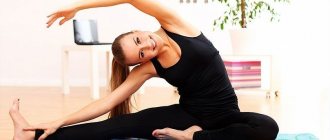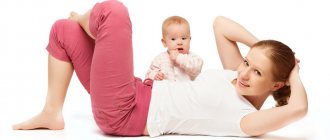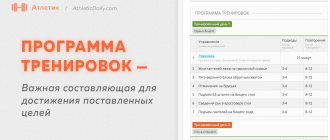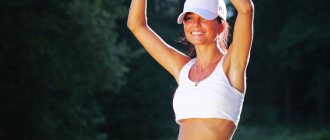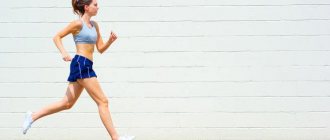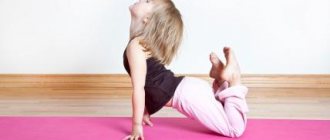You often hear: “I would start working out, but it’s too late for me” or “I would bring my son to the gym, but it’s too early for him.” In most cases, these are just excuses and a desire to justify one’s laziness in the eyes of others and one’s own.
If you are trying to find clear age limits for bodybuilding, then this idea is doomed to failure. Neither among athletes nor among doctors there is a consensus on this matter. Let's figure out why and try to outline the framework “from” and “to”.
How to pump up a teenager?
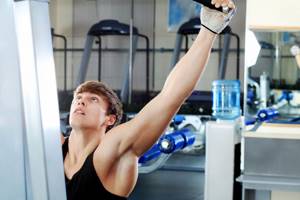
It is no secret that it is much easier for teenagers to pump up and create an athletic body than for people over 30 - the level of hormones responsible for weight gain and muscle growth reaches its maximum values between the ages of 13-14 and 18-20. During this period, the so-called bone growth zones are open in boys and men - this greatly facilitates the task of expanding the shoulders and strengthening the skeletal structure.
Unfortunately, strength training at an excessively early age can negatively affect the overall growth of a teenager - it is important to remember that the training program in the gym for guys under 18-19 years old should not include heavy exercises with a barbell that put stress on the spine (primarily , squats). Among other things, teenagers should pay special attention to joint safety when exercising.
The optimal solution for teenagers who want to gain weight would be to combine training to broaden the back (primarily pull-ups and lat pulldowns), exercises to improve posture and abdominal exercises with regular swimming or other active sports. Then, after reaching the age of 18, it is recommended to switch to barbell training.
Training program for teenagers
Most strength-building exercises for muscle growth and mass gain performed with free weights (that is, with a barbell or dumbbells) place vertical stress on adolescent joints that are not yet fully formed, causing spinal curvature or even growth retardation. Machine exercises and bodyweight training are much safer than squats or barbell deadlifts.
For teenagers under the age of 15-16, regular swimming is best for developing muscles - it can easily turn a skinny boy into a broad-shouldered guy. You can start strength training on machines (or home exercises with dumbbells) at the age of 16-17, and start fully lifting with a barbell no earlier than at the age of 18. You can improve your abs at any age, especially with the abs program for beginners.
Children's strength training
During exercise, it is important to pay attention to the correct position of the body: poor posture, coupled with power loads, can lead to curvature of the spine. Loads should be moderate and should be increased gradually. Teenagers cannot perform squats with a barbell, standing presses, but bench presses are allowed.
The peculiarity of strength training for adolescents is that it results in an increase primarily in muscle strength rather than volume. In childhood, little androgenic hormones are produced, which are responsible for muscle growth. It is important to consider this fact: a slow increase in muscle mass does not mean that the training is not effective enough.
According to the recommendations of scientists from the Academy of Pediatrics, the best choice to start exercising is to use your own weight. After the child has firmly mastered the correct technique for performing all exercises, it will be possible to move on to strength training using special equipment:
- children's exercise equipment;
- expanders;
- free weights.
You can perform 1-3 approaches per workout for each muscle group. The weight of the weight is selected so that in 8-15 repetitions the teenager reaches the level of average fatigue, and not muscle failure.
The optimal frequency of classes is two to three times for an hour every week. Workouts should begin with a warm-up and end with stretching. The main part of the lesson - directly working with power loads - should last 20-30 minutes.
How to gain weight for a teenager?
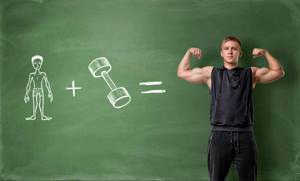
To gain weight, adolescents aged 13-16 years are recommended to regularly train with 3-4 sets of key exercises with body weight - push-ups and parallel bars, pull-ups and squats without additional weight. Also, visit the pool at least 2-3 times a week, devoting at least 30-45 minutes to swimming in different styles. Try to swim at least 1 kilometer per workout.
After a month of regular swimming, teens can begin a home dumbbell workout program—including doing exercises like dumbbell curls or squats. However, remember that the main point in the processes of muscle growth and mass gain is not mechanical lifting of weights, but control of movement and ensuring the involvement of the “right” muscle groups in the work.
Does a horizontal bar help you grow taller?
Learning how to do pull-ups correctly on a horizontal bar is much easier with a teenage weight of 50 kg than with an adult weighing 70-80 kg - and ideally performed pull-ups develop not only the muscles of the back and shoulders, but also pump up the muscles of the arms (primarily the biceps) and even the abs. Although the horizontal bar itself cannot help you grow, it will allow you to noticeably stretch out in height. Fitseven talked about other methods of increasing height earlier.
Despite the fact that pull-ups on the bar cannot increase the physical length of the spine (a person’s height is largely determined by his genetics and nutrition in childhood and school age), they have a positive effect on posture. This is especially important in adolescence, when sitting for many hours at a school desk easily forms various curvatures of the spine.
At what age can you start going to the gym?
At the age of 13-16 years, the skeletal system is formed and the child’s hormonal levels are stabilized. For this reason, strength training is contraindicated for children under 16 years of age: it will cause irreparable harm to an unformed skeletal system.
You should start introducing your child to sports with exercises that do not require the use of weight:
- stretching;
- push ups;
- working on the abs;
- classes on aerobic exercise equipment (treadmills, exercise bikes, steppers, etc.).
Teenagers over 16 years old can visit the gym 2-3 times a week. The recommended duration of the lesson is one hour. Professionals advise, if possible, to alternate between working on exercise equipment and outdoor games: table tennis, basketball, football.
Exercises on the horizontal bar
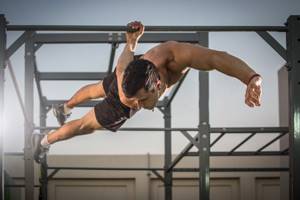
Training on the parallel bars and horizontal bar (including pull-ups, dips and other exercises) is especially important for teenagers who want to quickly build up their back and chest muscles. Such training builds strong shoulders and powerful arms (primarily triceps and forearms). In addition, on the uneven bars you can easily perform exercises on the abdominal muscles, performing all kinds of leg lifts and hanging crunches.
Teenagers can start doing parallel bars exercises starting at the age of 13-14 years (in the absence of direct contraindications). The best effect for the development of a teenager’s figure, weight gain and muscle growth will be the regular combination of swimming in various styles, all kinds of pull-ups on the horizontal bar, push-ups on the uneven bars, as well as a program of complicated push-ups from the floor.
Program in the gym
Despite the fact that teenagers can start moderate training on exercise machines after the age of 16, at this age it is still better to focus exclusively on swimming, pull-ups, push-ups and various abdominal exercises. It is better to start fully pumping muscles and strength training when the body is already prepared for the load and knows the mechanics of the basic exercises.
Boxing is a safe sport for children
Boxing is indeed a relatively safe sport for children. Classes are conducted under the guidance of an experienced trainer. Novice athletes do not spar with each other in the ring. The main exercises in training are jumping rope, jumping, running, endurance exercises and practicing technique on the punching bag. That is why boxing can be called one of the safest sports for children. But, despite the low risk of injury, when registering for a section, a child needs medical insurance to practice boxing; this is a requirement of the sports federation. You will also need permission to attend classes from a therapist.
Contraindications to classes:
- Chronic ENT diseases;
- Diseases of the musculoskeletal system;
- Diseases of the respiratory system;
- Diseases of the cardiovascular system;
- Head injuries;
- Skin viral and fungal diseases;
- Endocrine pathologies;
- Diseases of the genitourinary system and gastrointestinal tract.
If a teenager has these diseases in an acute form, boxing is contraindicated for him. But over time, if the general condition improves, the doctor may give permission to train.
How to pump up a teenager's arms: training for young men
All representatives of the stronger sex want to have a beautiful, muscular body, and even more so teenagers and young men. Everyone pursues their own goals: some want to show off in front of girls, others dream of building a foundation for further professional development in sports, some try to look intimidating in order to protect themselves from attacks from enemies among their classmates. In this article you will learn how to pump up the arms of a teenager.

What to eat
It is useless to pump up muscles if the diet does not contain the required amount of protein: in this case, training will only lead to accelerated muscle degeneration. Muscles work according to this principle: a large load destroys them, as a result the body tries to build up protein fibers with a reserve, because it is “afraid” of more difficult tests. The building materials are amino acids contained in protein molecules.
It is also necessary to take into account that children and adolescents, even in the absence of strength training, need increased nutrition for growth. Young athletes need to eat even more protein than professional adult bodybuilders. The teenage norm is 3-4 grams of animal protein per kilogram of body weight (for comparison, a bodybuilder needs 1.5-2.5 grams). The reason for such a large dose is the maturation of the adolescent’s body. Proteins perform many important functions: they are hormones of all types, speed up the work of the nervous system, stabilize metabolism, strengthen bones, joints and ligaments.
Proteins are found in the following foods:
lean sea fish;
meat (especially white varieties);
dairy products (cottage cheese, hard cheese, milk);
buckwheat, containing all essential amino acids.
It is better to start drinking special protein shakes at the age of 18-20 years, not earlier.
Fresh vegetables, fruits, berries, and cereals are no less useful. Greens are especially useful: lettuce, dill, parsley.
It is advisable to almost eliminate harmful foods from the diet: fast food, sweets with artificial sugar, smoked foods. You need to drink at least 2.5 liters of water with lemon juice. It is better to avoid coffee and strong tea, because these drinks retain fluid in the body, which delays weight loss and causes swelling of the limbs.

At what age can you send your child to boxing?
Boxing cannot be called an early sport. The optimal age to enroll in the section is 9-10 years old. At an earlier age, when the baby has not yet strengthened all the body systems, exercise can be harmful to health. For example, if you send a child at the age of 5-6 to boxing, this can lead to curvature of posture.
When registering for the club, the coach will assess the child’s physical condition and ask him to do several exercises. The good thing about boxing is that when entering school there is no strict selection process, such as in gymnastics, where they take guys with a certain level of training.
Will a horizontal bar help?
There is an opinion that exercising on the horizontal bar helps you grow taller. Growth is 70% genetic and 30% nutritional. No amount of exercise will help you grow a lot. However, in adults, after prolonged exercise on the horizontal bar, an increase in height by 2-4 centimeters was observed. This happened when the bones and cartilage of the spine, compressed from an unhealthy lifestyle, returned to their original position due to improved blood circulation. Static stretching exercises such as yoga and Pilates can also help “rejuvenate” the spine.
However, teenagers need to remember: the horizontal bar forms correct posture. A straight, dignified back, broad, muscular shoulders and a flexible neck can visually add 5-7 centimeters to your height. In addition, proper circulation of blood and lymph throughout the body contributes to better distribution of nutrients throughout the cells, which makes nutrition more effective without increasing portions.
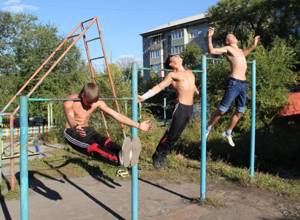
Vertical load on the spine
This type of load is otherwise called axial impact. It involves vertical pressure on the spinal column.
Axial load is usually divided into the following types:
Strong – which extends directly to the spine when standing or bending.
Weak – affects the ridge indirectly.
Static - similar to the first type, only it occurs absolutely without tilting.
Let's consider each type of vertical load in more detail:
Strong axial load
It spreads “in portions”: the weight either presses on the shoulders or pulls off the arms. Most often includes dynamic exercises. It is better for teenagers 13-16 years old not to abuse this type of physical activity.
This work of the spine includes:
various variations of barbell squats;
bends and lunges with a barbell;
all types of deadlifts.
Such physical exercises are best performed by boys over 17-19 years old.
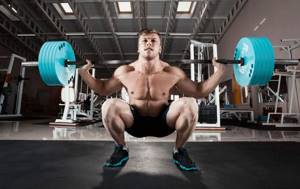
Weak vertical
This set of training elements is more gentle. This variety does not allow you to bend over with weights or lift heavy weights.
dumbbell press;
lunges with dumbbells;
small weight kettlebell jerk.
Such elements can already be included in the training scheme for teenagers 16-17 years old.

Static load
The exercises are considered relatively simple for adults, but are strictly prohibited for young men. The main and practically the only permitted element is the pull of barbells or massive dumbbells to the belt.
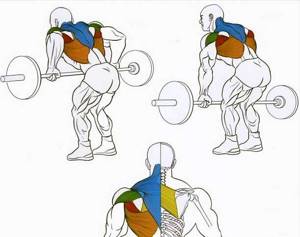
Exercises without vertical load on the spine
These exercises are the safest, and in some cases, lighter versions are recommended even for kindergarteners.
with your own weight - push-ups, pull-ups, planks;
elements performed in a lying position - bench press of dumbbells and an empty bar;
The ideal age for starting such exercises ranges from 3-4 years for stretching to 16-17 for empty bar presses.
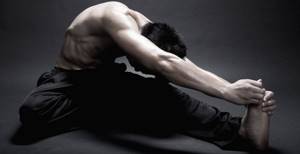
One can do it at sixteen, and the other
There is nothing to do in the gym before the age of sixteen. If you were involved in athletics before this age, welcome to training; if not, then before a full training process you need to “wake up” your body. It will take a couple of months of preparation.
Someone will say: “But, for example, Arnold Schwarzenegger at the age of sixteen was already a bull!” There was, I won’t argue. But he is the exception, not the rule. You can find thousands of examples, against Schwartz alone, when teenagers suffered serious injuries and health problems. Do you need it? Let your body form.
Nobody forbids leading an active lifestyle, doing push-ups, or doing pull-ups. Believe me, the end result from the fact that you came to the gym not at fourteen, but at sixteen, will only be better. Imagine that you are building a house and working on its foundation, this is already the beginning of work, important and responsible.
Program in the gym
Classes in the gym and fitness club are recommended for teenagers under 16 years old only for the sake of the “atmosphere”. After all, performing complex deadlifts and lifting heavy equipment is still prohibited. The best option is to continue training with your own weight (the same push-ups and pull-ups) only under the supervision of an instructor or an experienced mentor.
A complicated training program for teenagers should look like this:
use of a universal expander;
lifting small dumbbells.
The use of barbells and weights is highly discouraged. The best option is to combine training in the gym with classes at home or in sports clubs.
Reverse push-ups
In the gym, you can perform this version of push-ups - with emphasis on a stable sports bench. In this case, the triceps will be purposefully pumped.
Starting position: palms placed on a hill, feet standing on heels hip-width apart.
Bend your elbows and lower yourself down until your buttocks almost touch the floor.
Having lingered at the lowest point, you need to smoothly return to the starting position.
The exercise is very effective, so you need to perform it at least 2-3 sets of 20 repetitions.

With elastic band
Exercising with an elastic band can help you pump up in no time. It’s very simple to train: stand in the center of the band, place your feet on it shoulder-width apart, and grasp the handles of the apparatus in your palms. You need to bend your arms at the elbows, raising your hands to the level of your collarbones, and then smoothly lower your palms down. If the tension of the elastic bands is not very high, you need to perform 4-5 sets of 15-20 movements.

With dumbbells
Such exercises must be performed under the supervision of a mentor. Teenagers should not train with heavy weights. The weight of the projectiles should not exceed 5-7 kilograms, even if you have training, natural pumping potential and physical endurance.
The most common exercises:
Shoulder press. Starting position: sitting on a bench, dumbbells are at shoulder level. Straightening your arms, you should raise the shells above your head, hold for a couple of seconds and return to the starting position.
Lifting to the sides. Standing straight, shoulder blades retracted, arms along the body. The projectiles should be raised to the sides and lowered slowly. This exercise is great for working your shoulders.
Bent over climb. In a standing position, you need to bend over and raise your arms to shoulder level, stay in this position for two to three seconds and return to the starting position.
Lifting with a turn. When lifting a dumbbell with a neutral grip, you need to turn your hand inward halfway “all the way” to your shoulder. You can make several movements with the brush back and forth. It is necessary to return to the starting position in the same way as with normal bending of the elbows with a projectile. Do it alternately or simultaneously with both hands.
Hammer curls. While standing or sitting on a bench, take a dumbbell with a neutral grip and, as you exhale, lift it to your shoulder. The projectile must be vertical in the air so that the pancakes are located in the same plane on top of each other. As you exhale, lower the dumbbell.
One arm lift. Sitting with your body slightly tilted forward, place your elbow on your thigh. Perform “concentrated” bending with one hand, and the free one should rest on the knee.
It is very useful to alternate exercises: load your shoulders and biceps on different days.
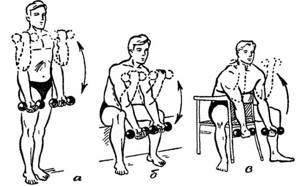
Child and bodybuilding
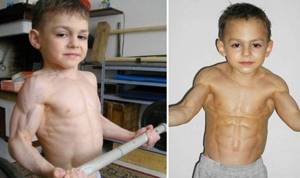
There are many sports where you can send a boy: you want to play football, you want to swim in the pool. The body is growing rapidly; this is not the time to load it with iron; the risk of injury is high. Some doctors suggest that children should exercise, but not do exercises that overload the spine (deadlifts, squats, etc.) and generally not overdo it.
Have you ever gone to the swimming pool?
They say:
- Jump from a three-meter tower, but you can’t jump from a five-meter tower!
Maybe I'm doing something wrong, but I went and jumped from five meters. I'm sure a teenager in the gym will behave according to the same principle. Just jumping from five meters is fun, but lifting the barbell is dangerous.
For mothers of boys: 5 dangerous consequences of taking steroids. Tell your son now
According to sports doctors, before the age of 16, training with barbells and weights is out of the question. And after reaching this age, you can only engage in athletics under the guidance of a coach. But what to do if the boy is determined to pump up his muscles?
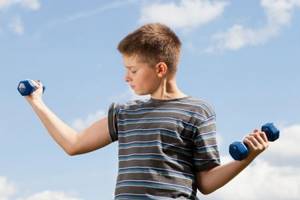
13-year-old Dima came home with a torn jacket after a clash with high school students. This is not the first time - the guys from 11th "B" become attached to him every day. I don’t like the fact that he’s a “nerd” - he studies well, he understands computers better than anyone else in school, but at the same time he’s overweight and can’t stand up for himself. The doctor explained that many boys at the beginning of puberty accumulate fat under the skin, which the body then burns and uses as biological fuel during accelerated growth and accumulation of muscle mass. But Dima did not calm down, he decided: “I will pump up my muscles, I will become an athlete!” “Is it possible for him to exercise at this age, isn’t it harmful?” - Mom was worried.
It is believed that exercises with dumbbells (weighing no more than 1.5 kg) are allowed for adolescents from 14–15 years old, and only on the condition that they are performed in the “lying on your back” position, but in no case standing or sitting. The only acceptable way to pump up muscles for a 12-13 year old boy is to use his own body weight as a training device, doing push-ups, pull-ups, and all kinds of hanging on the bar. However, even at the age of 16–18, it is they, and not training with a load, that should form the basis of training.
Boxing for children: pros and cons
Boxing for a child is an opportunity to learn to stand up for themselves, develop their body and improve their health.
The advantages of this sport include:
- Strengthening character and will;
- Development of endurance and courage;
- Development of discipline and self-control;
- Development of reaction and coordination of movements;
- Strengthening all body systems.
Any martial arts for children, such as boxing or wrestling, help children become more confident. They conquer their fear not only of an opponent, but also of various life circumstances, such as exams at school or going to the dentist.
Some parents, especially mothers, are against this sport; in their opinion, the child will definitely “break something” and also receive a traumatic brain injury. Yes, there are risks of injury in this discipline, but they are high only for professional athletes performing in the ring. Children encounter such risks extremely rarely and only when the teenager is not treated by a professional trainer, but, for example, by a father or a friend of the parents who does not know the specifics of teaching children.

